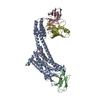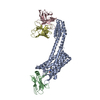+Search query
-Structure paper
| Title | Antibodies expand the scope of angiotensin receptor pharmacology. |
|---|---|
| Journal, issue, pages | Nat Chem Biol, Year 2024 |
| Publish date | May 14, 2024 |
 Authors Authors | Meredith A Skiba / Sarah M Sterling / Shaun Rawson / Shuhao Zhang / Huixin Xu / Haoran Jiang / Genevieve R Nemeth / Morgan S A Gilman / Joseph D Hurley / Pengxiang Shen / Dean P Staus / Jihee Kim / Conor McMahon / Maria K Lehtinen / Howard A Rockman / Patrick Barth / Laura M Wingler / Andrew C Kruse /   |
| PubMed Abstract | G-protein-coupled receptors (GPCRs) are key regulators of human physiology and are the targets of many small-molecule research compounds and therapeutic drugs. While most of these ligands bind to ...G-protein-coupled receptors (GPCRs) are key regulators of human physiology and are the targets of many small-molecule research compounds and therapeutic drugs. While most of these ligands bind to their target GPCR with high affinity, selectivity is often limited at the receptor, tissue and cellular levels. Antibodies have the potential to address these limitations but their properties as GPCR ligands remain poorly characterized. Here, using protein engineering, pharmacological assays and structural studies, we develop maternally selective heavy-chain-only antibody ('nanobody') antagonists against the angiotensin II type I receptor and uncover the unusual molecular basis of their receptor antagonism. We further show that our nanobodies can simultaneously bind to angiotensin II type I receptor with specific small-molecule antagonists and demonstrate that ligand selectivity can be readily tuned. Our work illustrates that antibody fragments can exhibit rich and evolvable pharmacology, attesting to their potential as next-generation GPCR modulators. |
 External links External links |  Nat Chem Biol / Nat Chem Biol /  PubMed:38744986 PubMed:38744986 |
| Methods | EM (single particle) |
| Resolution | 3.0 - 3.3 Å |
| Structure data | EMDB-41248, PDB-8th3: EMDB-41249, PDB-8th4: |
| Chemicals |  ChemComp-Y01:  ChemComp-LSN: |
| Source |
|
 Keywords Keywords |  SIGNALING PROTEIN/IMMUNE SYSTEM / SIGNALING PROTEIN/IMMUNE SYSTEM /  G protein-coupled receptor / G protein-coupled receptor /  nanobody / nanobody /  SIGNALING PROTEIN-IMMUNE SYSTEM complex SIGNALING PROTEIN-IMMUNE SYSTEM complex |
 Movie
Movie Controller
Controller Structure viewers
Structure viewers About Yorodumi Papers
About Yorodumi Papers










